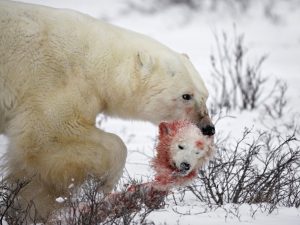Jules Galligan – Geology
Olivia Smith – Pre-Veterinary Science
Kathy Tran – Animal Science
 A polar bear carries away it’s meal for the day–a young cub.
A polar bear carries away it’s meal for the day–a young cub.
Image retrieved from: http://www.trvl.com/cache/img/c-1024-768/wp-content/uploads/2012/09/047-130136481-11.jpg
One cold, icy December afternoon, researchers scanned the Arctic ice below, hoping to track a polar bear they tagged a few months earlier expected to recently give birth to cubs. In the distance, a splash of red caught their eye–a polar bear presumably feasting on a previously killed seal. As they got closer they could not believe their eyes. To their dismay, the mother bear they had been tracking was ripping apart a clump of white fur–her own cub. The bear looked up as they approached, the cub’s head dangled from the mother’s mouth. This polar bear cannibalism was not their first encounter. In fact, studies show that more polar bears are practicing cannibalism more frequently for the purpose of securing reliable sources of nutrition (Amstrup, Stirling, Smith, Perham & Thiemann, 2006). Continue Reading